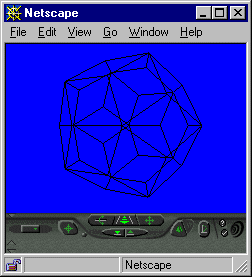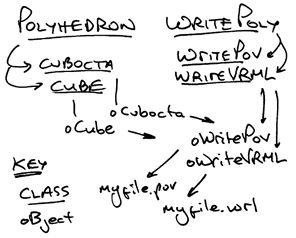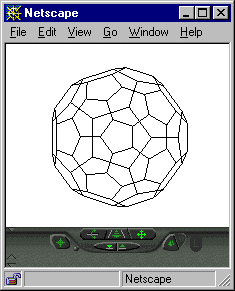 |
The VRML viewer expects a text file, just like Povray does, but
wrl format is significantly different from the pov
format.
For this demo, we use the IndexedLineSet feature to implement a
simple wrl file with a structure very similar to the Points
and Edges tables internal to each polyhedron object.
First, all n points associated with a shape get listed in
xyz format.
Next, a list of edges refering to these points by number, using 0
(first point) through n-1 (last point), defines the wireframe
mesh.
|
|
The WriteVRML
class uses its
startdata() method to dump the Points table in record
number order. By the time startdata() is
finished, our wrl file looks like this:
#VRML V1.0 ascii
DEF BackgroundColor Info { string "0.0 0.0 1.0" }
Material { diffuseColor 1 0 0} #end Material set to blue
Coordinate3 {
point [
0.7071068 0.7071068 0.7071068,
-0.7071068 -0.7071068 0.7071068,
-0.7071068 0.7071068 -0.7071068,
0.7071068 -0.7071068 -0.7071068,
]
}
IndexedLineSet {
coordIndex [
Then the rest
of
writeoutput(), a method inherited from the WritePoly
superclass, invokes writeEdge() repeatedly
to output edges. The writeEdge() method
gets Point table record numbers passed as r1 and
r2 to
synchronize its node references with the above point
set:
procedure writeEdge(a,b,c,d,e,f,r1,r2)
=fputs(this.hnd,space(10)+str(r1-1,3)+", "+str(r2-1,3)+ ", -1,")
return
endproc
Since the
WriteVRML subclass has its own version of thewriteEdge()
and
writePoint() methods, it ignores the superclass
versions. This is how inheritance works: if a subclass has its own
version of a method, execute it here and now -- otherwise pass the
buck up the chain of command, until some superclass method by the
right name is found. The same goes for properties: if a property
isn't mentioned by name in a subclass definition, browse the family
tree to discover where it appears in an object's lineage -- as
defined by the class hierarchy.
By the time
the
writeoutput() method is finished, we have the
balance of our wrl file, ready for loading in a VRML viewer,
such as CosmoPlayer, a free plug-in for the Netscape web
browser:
0, 1, -1,
0, 2, -1,
0, 3, -1,
1, 2, -1,
1, 3, -1,
2, 3, -1,
]
}
Note: The -1s occuring after each edge (or node-pair) function as
"line breaks", telling the viewer to consider the next node the
start of a new edge, and not a continuation of a "connect the dots"
series.
|



